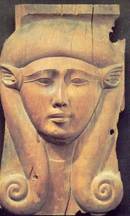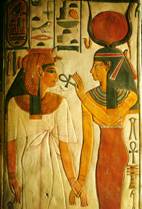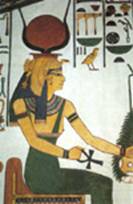Hathor – Earth’s Ring of Debris
The Egyptian Mothering Goddess Hathor

Anybody who is vaguely familiar with ancient Egypt is aware it comprises of many hundreds of mythological deities – Amun, Osiris, Horus, Hathor, Isis and Ptah to name but a few. Convention wisdom says the ancient Egyptians invented these gods in an attempt to explain the workings of the cosmos and their place in it. That is to say, the simple rising and setting of the sun, moon and stars and the subtle changes in the environment were somehow encapsulated in the many thousands of myths, legends and stories attributed to some 2,000 gods in all.
I question this premise by asking some very fundamental questions, such as, how does the invention of so many imaginary deities attributable to no physical thing or phenomenon explain the workings of the cosmos? How many gods do you need to explain one of the sunniest and driest climates in the world? If Egypt’s pantheon of gods is an attempt to explain the universe and the Egyptians place in it, then why is so alien to us – why can’t we even begin to associate with it? The only two things that separate us from our ancient forebears are time and technology; if we were to subtract these, would we see the world in the same bizarre way?
In my book I show there is only one plausible explanation for this extraordinary world and in a roundabout way it doesn’t deviate from the orthodox view – the Egyptians were indeed attempting to explain the workings of the cosmos only this wasn’t the same relatively stable world we experienced today, far from it. It was a world dominated by 3,000 years of cosmic chaos (duration of Pharaonic Egypt) primarily involving the planets Mars, Venus, Mercury and the Moon which entered into repeated encounters with earth as divine kings and queens – celestial bodies believed to be the kas (doubles) of humans here on earth (See gks 1).
Moreover, my reconstruction takes the common sense notion that there were no mythical gods whatsoever in ancient times. All of Egypt’s gods did at some point hold real physical presence; all can be attributed to planetary chaos and any phenomena associated with it. And by this I am referring to asteroids, cometary bodies, dust and gasses, electromagnetic disturbances, lighting bolts, light refraction, shock waves, light apparitions, etc. etc. It is here where we will find the true physical identification for many of Egypt’s so-called mythical gods. The reason we cannot identify with the ancient world and its enigmatic ‘sky’ gods is because chaos has all but subsided and any phenomena associated with it is no longer extant.
A prime example of a deity that once held true physical presence but has since dissipated is the mothering goddess Hathor (Figure 1 above). I identify this bovine goddess as the name given to a gigantic cosmic ring of ‘milky’ debris that once orbited around earth’s equatorial regions. An analogy would be Saturn’s rings only much thicker and denser.
In order to corroborate this ground-breaking identification it is necessary to first briefly explain how earth gained a gigantic ring(s) and then follow with how the Egyptians deified this in the form of the nurturing goddess Hathor. It will be shown that Hathor’s images, attributes and epithets are completely consistent with a giant cosmic hazy band of debris arching across the heavens. Further, by invoking the God King Scenario it will become apparent why and how Hathor, as Earth’s hazy ring, played such prominent role in the lives of the celestial god kings. This, in turn, providing further corollary support for the GKS.
Approximately 5,200 (3,200 BC) years ago cosmic chaos began when a giant interloper entered our solar system and smashed into the largest planet, Jupiter. The force exerted upon Jupiter was enough to blast the Earth into smithereens many times over. It caused an apocalyptic explosion which resulted in the birth of Venus as well as unimaginable quantities of space debris (including our Moon) and a Dark Age on Earth (The Dark Age of 3,200 BC. See Geological Evidence).
The evidence for the initial cataclysmic explosion on Jupiter is still with us today in the form of Jupiter’s Great Red Spot (erroneously believed to be a raging storm) and the asteroid belt which is a rocky band of debris orbiting between Mars and Jupiter.
The impact was of such high velocity that it caused a SOLAR-SYSTEM-WIDE catastrophe scattering dust, gases and debris throughout the ecliptic plane, the flat disk on which the sun and the planets lie. The sun (& planets) was a spinning star cocooned in a pea-soup of haze and gasses as a gigantic flat ring of debris formed stretching out from the sun and beyond the outer planets Jupiter, Saturn and possibly even as far out as Uranus and Neptune. This ‘ecliptic haze’ was constantly fed by ongoing planetary chaos primarily involving the planets Jupiter, Mars and Venus. Jupiter churning out countless tons of debris for several millennia after its initial ‘eruption, Mars and Venus in entering into repeated encounters with earth also subsequently scattering countless tons of debris throughout. The sun (Re) with the assistance of the afore mentioned planets ultimately vacuumed up this debris – a process that took at least 3,000 years and comes to us via the wars and battles of the warrior sky pharaohs (the kas) and the sun gods eternal battle against the forces of evil.
Isis, Ptah and Sokar

From the prospective of earth, the ecliptic debris appeared as a hazy band arching across the night sky on an east-west axis (apparent path of the sun and planets today). The Egyptians believed it was created by the god Ptah (Jupiter) and described it as a giant mental plate that was the floor of heaven and the roof of the sky. I identify Ptah (image on right) as Jupiter which I believe was clearly seen amidst the ecliptic haze as a gigantic star (sometimes blue, hence blue skullcap). Ptah’s epithets completely consistent with my identification – i.e. he was the god of craftsmen, rebirth and creation… a master architect, one who made all and created the gods and framer of everything in the universe.

Descending the stairway to heaven and moving much closer to home the ‘ecliptic haze’ was deified as the goddess Isis. As the Queen of Heaven, the Brilliant One in the Sky, Great Lady of Magic, Mistress of the House of Life, mother of the pharaoh, Isis is to be seen as a goddess who basically presided over the path (the ecliptic) taken by the sun (Re) and the god king planets as they reigned over earth.

Ra the Red Sun

The evidence for the existence for the ecliptic band of debris that once engulfed our solar system comes to us via the art of the Egyptians and the way in which they portrayed the sun (Figure 5 Ra, the RED SUN). The Egyptians always depicted the sun, not as a golden yellow ball with a complete set of sunrays as we would paint it but as a relatively lifeless RED disk, why? The answer is so simple it beggars belief. The Egyptians drew, painted and carved a red disk because the sun in ancient times appeared as a red disk. Our sun, the very same sun of ancient times appeared red because it was hazed behind 93 million miles (distance between the sun and Earth) of dust and debris – the elliptic haze. The Egyptians depicted EXACTLY what they saw when observing the sun. They would never tempt the wrath of their pre-eminent deity (Re) by getting his true form (that of a golden glaring orb) wrong. This, and the fact that the planets in chaos appeared as red disks is the very reason why the red disk dominates Egyptian art. I cover the Red Sun more comprehensively in my book but its worth mentioning now because it effects what follows (Also, please note when studying Egyptian art, the lack of a simple white crescent moon, why? Because it had yet to settle down into its regular monthly cycle).
A natural sequential order of things saw masses upon masses of the ecliptic debris tidally drawn in towards the planets forming gigantic ring systems around their equatorial regions. The ‘Lord of the Rings’ Saturn (Sokar) a prime example. In fact, I believe Saturn’s rings today are the remnants of a once much thicker and denser ring system that existed only a few thousands years ago. But of importance here is Earth also developed one enormous band of debris around its girth. Forming shortly after the birth of chaos and remaining for at least 3,000 years (Pharaonic Egypt) it was constantly fed by ongoing chaos. It also periodically contributed (along with the ecliptic haze) in diminishing the sun red from the perspective of Earth. Although a ring to modern day minds, from the perspective of ancient cultures who believed the earth to be flat and the centre of the universe, earth’s celestial ring arched across the heavens on an east-west axis (celestial equator) as a thick hazy band of milk and honey. It was clearly seen during the night, twilight hours and also during the day, although this would depend upon the intensity of chaos and just how bright the red sun (Re) was allowed to shine.
Unlike the ecliptic which moves throughout the day and slowly throughout the seasons as a result of earth spinning on its axis and its orbit around the sun, earth’s band remained a virtually constant east-west feature. It should be seen as a visible form of earth’s celestial equator (earth’s equatorial region projected upon the sky) as it spun with earth in a relatively constant motion (chaos permitting).
Hathor – time to grant this enigmatic goddess real physical status.
Earth’s ring of debris was deified as the goddess Hathor.
Egypt’s Hathor Goddess – Earth’s ring of debris
By examining the epithets and attributes of this deity, it will become clear that the connection is related to Earth’s rings.

‘Important bovine goddess worshiped in three forms; as a woman with the ears of a cow, as a cow, and as a woman wearing a headdress consisting of a wig, horns and Sun disk. Her associations and cult centres were among the most numerous and diverse of any of the Egyptian deities.’ (Dictionary of Ancient Egypt, Shaw & Nicholson p 119)
If we look at a selection of Hathor’s titles, we immediately find a link between Hathor and Earth’s ring of debris. These titles include the following:

• Lady of the Sky
• Daughter of Re
• The mistress of heaven
• Lady of the stars
• Goddess of love, music and beauty
• Goddess of fertility, children and childbirth
• The Mothers of Mothers, the celestial nurse
• Goddess of the dead, lady of the west
• The mistress of life
• The great wild cow
• The golden one
• Mistress of Turquoise
• Lady to the limit of the universe
• The powerful one
• Mistress of the desert
• Lady of the southern sycamore
• Lady of malachite
• The great one of many names
All the above titles have deep significant meaning and all correlate with my identification of Hathor as a great ring of debris that once encircled Earth’s girth. There are many others as Hathor’s epithets were among ‘the most numerous and diverse of any of the Egyptian deities.’
Hathor – a variety of Colours and forms
Hathor traditionally took on more forms than any other Egyptian deity, many of whom were limited to only one or two shapes. In terms of imagery, she is the most fluid of all the Egyptian deities, rivalled only by the god of chaos, Seth. For example, the goddess Bastet appeared in two forms – as a cat and as a woman with a cat’s head. Hathor took on innumerable forms: woman, goose, cat, lion, malachite, sycamore fig etc. This is consistent with the infinite number of forms displayed by the hazy band of space debris over the millennia. Earth’s band was a hive of activity as asteroids, comets (kas of the AE’s), dust and gasses of all shapes and sizes combined to create a variety of manifestations.
As well as forging different shapes, at certain times of the day Hathor appeared in a kaleidoscope of colours, this depending on things such as the intensity of chaos, light refraction, day, night, dust, gasses, ice particles as well dust and gasses in earths atmosphere. All this and more would play a part Hathor’s colour – sure enough we find reference to this.
‘The Beautiful, with numerous colours…’
(Temple at Deir El-Bahari)
However, it is with titles such as ‘the lady of turquoise’ and ‘the golden one’ that we find Hathor’s more prominent colours. There are many references to gold and turquoise, especially turquoise, the Egyptians carried out many expeditions into the Sinai to mine for turquoise, Hathor’s most sacred colour. Turquoise was mined to venerate Hathor in her most prominent colour.
If I can draw your attention to image figure 6 above. Here traces of yellow and blue paint can clearly be seen on the Hathor’s face and wig. Such images should be taken at face value with the gold on the top and down the side of the wig as representing the middle part of earth’s band with the turquoise colouring at the ends as representing the further most east and west points. I would suggest this is a daytime representation of Hathor.
It would have been a spectacular sight and it is no wonder ‘her associations and cult centres were among the most numerous and diverse of any of the Egyptian deities.’
It is puzzling that scholars, when referring to Hathor as the golden one, refer to her close relationship with Re (daughter of Re) as the likely source of this title. This is incorrect because Re was depicted as red-coloured disk (Figure 5) and not golden, so there is no connection between Hathor’s golden colour and the Sun.
Hat-hor – “House of the King.”

Hathor Hieroglyph
‘The literal meaning of Hathor was ‘House of Horus,’ (hat-hor) and it was written in the form of a falcon contained within a hieroglyph representing a rectangular building (Figure 8). Since the pharaoh was identified with Horus, Hathor was correspondingly regarded as the divine mother of each reining king, and one of the royal titles was ‘son of Hathor.’ (ibid)
The planets in chaos (Mars, Venus, Mercury and the Moon) in undergoing repeated encounters with earth in the guise of the divine monarchy (kas) were many times… born in this ‘house,’ hence the titles ‘Mysterious One who gives birth to the divine entities…’ and ‘You from whom the Divine Entities come forth…’ They also reigned in this house, a divine relationship encapsulated in the title ‘son of Hathor.’ And, finally as they slowly moved away from earth towards the west, they died in this ‘house.’ That’s why Hathor was also known as the ‘Goddess of the dead, lady of the west.’ I cannot think of a more appropriate name for earth’s ring of debris than ‘house of the king’ – Hathor.
If we examine the orthodox belief of Hathor as a mythological figure it is actually nonsensical for how can the ‘house’ of an earth-bound human king be located in the heavens? Hathor was a sky goddess, this isn’t disputed but how can a human king inhabit the sky? My identification of Hathor allows us to take the literal translation of her name at face value.
Hathor Hairdo

The emergence of royalty amidst Hathor and the subsequent ‘mothering’ can be supported by looking at a very common image of Hathor. If I can draw your attention to figures 9, 10 and 1, 6. These particular images of Hathor with cow’s ears and an unusual hairstyle was standard and ubiquitous. It is regularly found atop architectural columns (to reach the heavens) and was traditionally used to decorate Hathor’s musical instrument, the sistrum.
Hathor’s hair was so distinctive that scholars have dubbed it the ‘Hathor hairdo.’ It was not a heavily bejewelled or elaborately braided hairstyle as was typical of ancient Egyptian imagery or custom. It was simplicity in the extreme and took the form of a simple quiff which was frequently parted down the middle and wrapped around Hathor’s face as part of an elaborate style.

I believe this particular trait, and in fact Hathor’s entire image, was wholly symbolic of Earth’s celestial ‘haze’ as it wrapped itself around the ‘royal’ celestial bodies. A universal cosmic phenomenon enveloped the kings as they were born to earth – the ‘lady to the limit of the universe’ wrapped herself around the kings as they took to the throne as ‘sons of Hathor.’
How else could the ancient Egyptians represent such a manifestation? The planets were gods; they were ‘swathed’ by a phenomenon that remained for millennium and this divine relationship demanded representation. Hathor was given a human face which symbolically represented the face of the king.
The debris which enshrouded the kings was represented by the ‘curling’ hairdo. The ancient Egyptians could not portray the king’s face within Hathor’s hair as this would merely be the king with the same hairstyle as Hathor which would be totally confusing. The kings did not become Hathor – they were merely nurtured by this goddess; they did not take on her attributes but emerged from within them. When the kings died and moved away from Earth to become stars (Osirians), they were occasionally portrayed in the image of Osiris (Seti would be one such king). This was understandable because they took on this god’s ‘star’ attributes, it’s the same principle.
Hathor’s bovine attribute – Saturn’s Moons suckling ‘milk’ from its rings – a phenomenon observed thousands of years ago.

Hathor’s most famous manifestation is as a cow. Even when she appeared as a woman, she often wore cow’s horns, or a pair of cow’s ears. Hathor is frequently depicted suckling the pharaoh, whether in the guise of the cow or as a sycamore fig, a tree that exudes a white milky substance. At the Shrine of Hathor; Hatshepsut (Venus), a queen who would rule as pharaoh and Tuthmosis III (Moon) are depicted bringing offerings to Hathor. Hatshepsut (Venus) is also seen nursing from the divine cow as seen in figures 11 and drawing 11a.

If we examine this image in more detail, we will see that Hathor is depicted as a very large cow with horns. There is also a large sun-disk between the horns; in the usual tradition this was once painted Red. Hatshepsut is shown at least a quarter of the size of Hathor and is kneeling below Hathor’s rear legs sucking milk from her udder.
The figure at the front, leading Hathor is the god Amun (in subsequent books I will give real physical identity to this god known as the ‘hidden one’).
This imagery may seem strange and unfamiliar to us. Are we to assume that ancient Egyptians lived in a world of giant cows? Why did they portray such a surreal scene? By using the GKS, I will show that such images had a purpose and came about as a direct result of observations of planetary bodies sucking material from earths rings. To explain this further we must visit Saturn’s rings.
Saturn is the sixth planet from the Sun and is the second largest in the solar system and its prominent ring system makes the planet one of the most beautiful objects in the solar system. Consisting mostly of ice particles with a smaller amount of rocky debris and dust Saturn’s rings brake up into countless narrow ringlets which resembled the grooves of an old-fashioned gramophone record.
Although there are countless rings, it is possible to make out bands with distinctive, bright features. Planetary scientists have sectioned out a least seven ‘bands’ and have labelled them A to G. Some of the gaps separating the bands have also been named. There is the narrow ‘Encke division’ and the larger ‘Cassini division’ which spans 5000 kilometres and separates the A and B rings. It is believed that these gaps were created by tiny satellites as they swept out bands of particles. For example, the two ‘shepherd’ moons, Pandora and Prometheus, orbit in gaps either side of the narrow F ring. They are known as shepherds because they prevent the ring particles from straying.
Saturn’s Ring Suckling Prometheus

A recent space probe called Cassini was sent to study Saturn’s rings and its moon, Titan, in September 2004 and made a remarkable discovery. It went through a gap in Saturn’s rings and captured an incredible image of the moon Prometheus ‘sucking out’ some of the dust particles from Saturn’s F ring. Here is a photo of this incredible event (Figure 12).
More information at NASA.
As can be seen, a faint stream of material or ‘streamer’ connects the moon to the ring. The moon is gravitationally perturbing the material as the satellite passes near to the ring – Prometheus is slowly ‘sucking on’ Saturn’s F ring.
This incredible event of a body sucking material from a planetary ring system was observed by humans long before we sent space probes to Saturn!
This phenomenon was observed thousands of years ago by ancient cultures throughout the world as they looked up and observed planetary kings and queens (& lesser bodies) sucking material from the enormous ring system (Hathor) that once orbited Earth. Further, such events were common place and took place on a far grander scale due to the heightened celestial events of 4,000 years ago.
In ancient times there was no ‘art for art sake,’ whether it be caved hieroglyphs, images or the jewellery worn by the monarchy, all had a connection to the gods and the worship of them. The above image of the Hathor giving milk Hatshepsut is no different; it is a symbolic representation of Venus in the guise of Hatshepsut, literally sucking material from Earth’s ring of Debris – Venus/Hatshepsut taking advantage of the nourishing generosity afforded by Hathor.
Another example of Hathor suckling can be found Cairo museum, here we find a statue that depicts Hathor suckling the pharaoh Amenhotep II. This represents Amenhotep as a facet of Mars within Earth’s rings ‘sucking’ in the finer dust and debris – Hathor suckling Mars.
It is a reoccurring image because Hathor remained for the duration of pharaonic Egypt and many pharaohs were observed sucking milk from the ‘Mothers of Mothers, the celestial nurse.’ It is clear that the nourishing manifestations of Hathor can easily be understood, and the iconography surrounding this goddess can be taken at face value.


